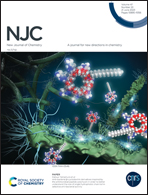Thiazolo[5,4-d]thiazoles with a spirobifluorene moiety as novel D–π–A type organic hosts: design, synthesis, structure–property relationship and applications in electroluminescent devices†
Abstract
A series of thiazolo[5,4-d]thiazoles with bipolar character has been designed and synthesized. Compounds 4a–d and 5a,b consist of a central thiazolo[5,4-d]thiazole as the electron acceptor (A) and a terminal 9,9′-spirobifluorene fragment as the electron-donor (D). Both key structural features are connected through the thiophene π-linker. The structure of all the compounds is fully π-conjugated providing proximity of the frontier molecular orbitals (FMO). Accordingly, thiazolo[5,4-d]thiazole-based compounds 4a–d and 5a,b exhibit excellent electronic structures with energy gaps falling in the range of 2.5–3.0 eV. Appropriate thermal stability and valuable photophysical properties make these molecules valuable for applications in optoelectronic materials. Hence, electroluminescent devices with 4b and 5b as host materials showed yellowish-green and yellow-green emissions, which is quite unique for organic-small molecules demonstrating their potential in the development of novel, low-weight and fully organic dopants for electroluminescent (EL) devices.
![Graphical abstract: Thiazolo[5,4-d]thiazoles with a spirobifluorene moiety as novel D–π–A type organic hosts: design, synthesis, structure–property relationship and applications in electroluminescent devices](/en/Image/Get?imageInfo.ImageType=GA&imageInfo.ImageIdentifier.ManuscriptID=D3NJ01633A&imageInfo.ImageIdentifier.Year=2023)


 Please wait while we load your content...
Please wait while we load your content...